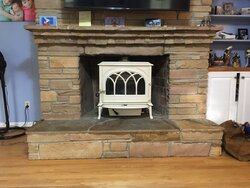We've been in our house for a little over two years now and have thoroughly enjoyed our fireplace:

However, I'd like to be able to use it for more than just ambiance, but rather to heat our 1880s farmhouse. Truth be told though I don't like the looks of most inserts. One of the things I really don't like is how small most of them are in relation to the actual fireplace opening, which necessitates what I refer to as "filler panels" on the top and sides. At the same time, I realize that a firebox as large as the fireplace opening would probably not be feasible. That said, something like this (Montlake 230) is close to what I would be looking for. I also like the fact that it protrudes from the fireplace opening and has a "shelf" where a kettle can be placed, etc...

Some specs on the fireplace:
Opening - 45" x 29"
Hearth Depth - 18.5"
Firebox Depth - 25"
Looking forward to some recommendations. *EDIT* Some specs on the house as well: 2600 SF total-1st floor is 1880s construction, somewhat drafty, 2nd floor is 1998 addition and much tighter. Heat is via oil fired hydronic baseboard. Fireplace is situated in a 15' x 20' room and first floor is mostly open layout.

However, I'd like to be able to use it for more than just ambiance, but rather to heat our 1880s farmhouse. Truth be told though I don't like the looks of most inserts. One of the things I really don't like is how small most of them are in relation to the actual fireplace opening, which necessitates what I refer to as "filler panels" on the top and sides. At the same time, I realize that a firebox as large as the fireplace opening would probably not be feasible. That said, something like this (Montlake 230) is close to what I would be looking for. I also like the fact that it protrudes from the fireplace opening and has a "shelf" where a kettle can be placed, etc...

Some specs on the fireplace:
Opening - 45" x 29"
Hearth Depth - 18.5"
Firebox Depth - 25"
Looking forward to some recommendations. *EDIT* Some specs on the house as well: 2600 SF total-1st floor is 1880s construction, somewhat drafty, 2nd floor is 1998 addition and much tighter. Heat is via oil fired hydronic baseboard. Fireplace is situated in a 15' x 20' room and first floor is mostly open layout.
Last edited:


